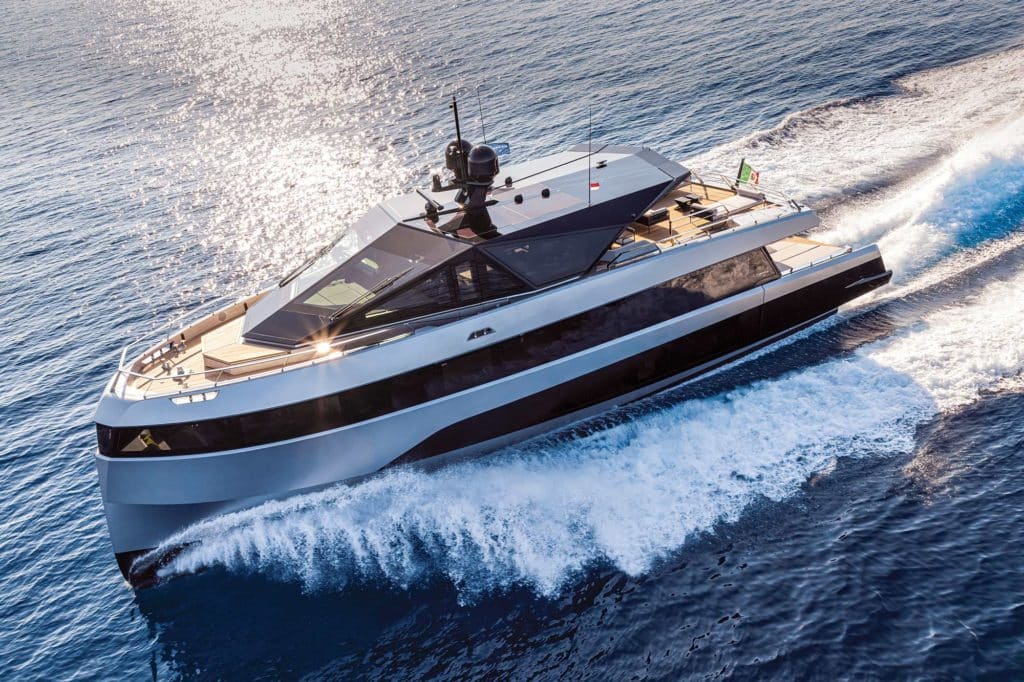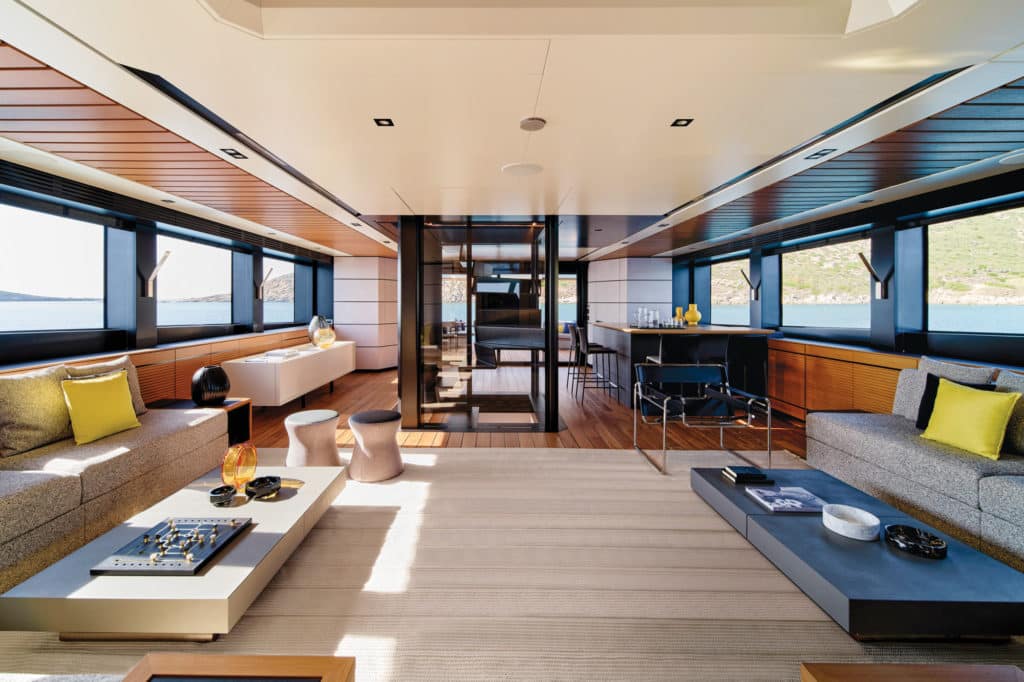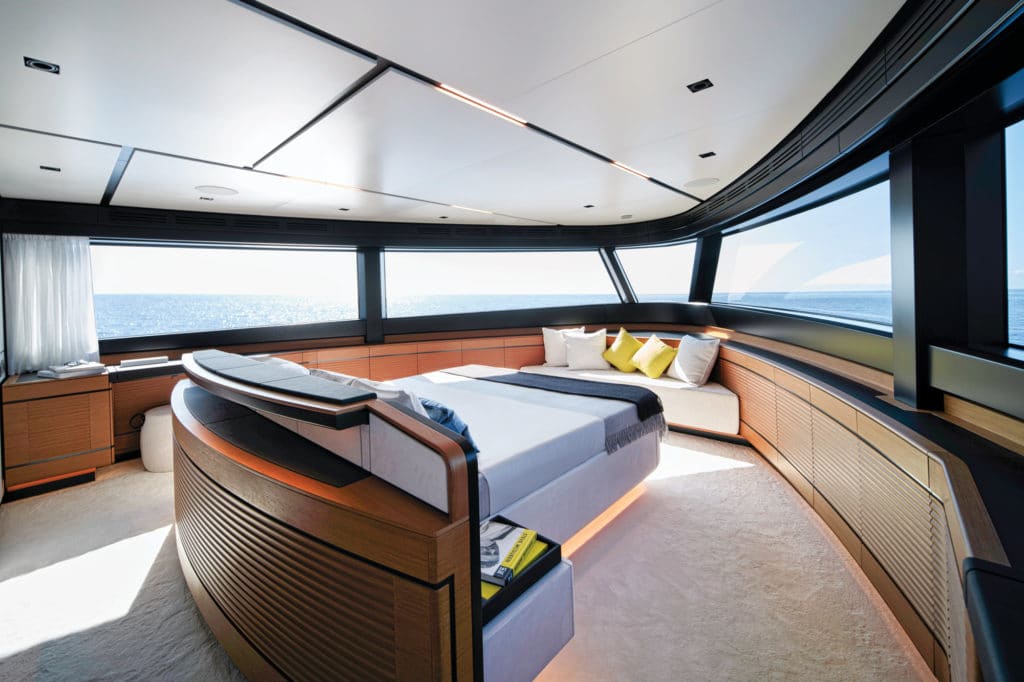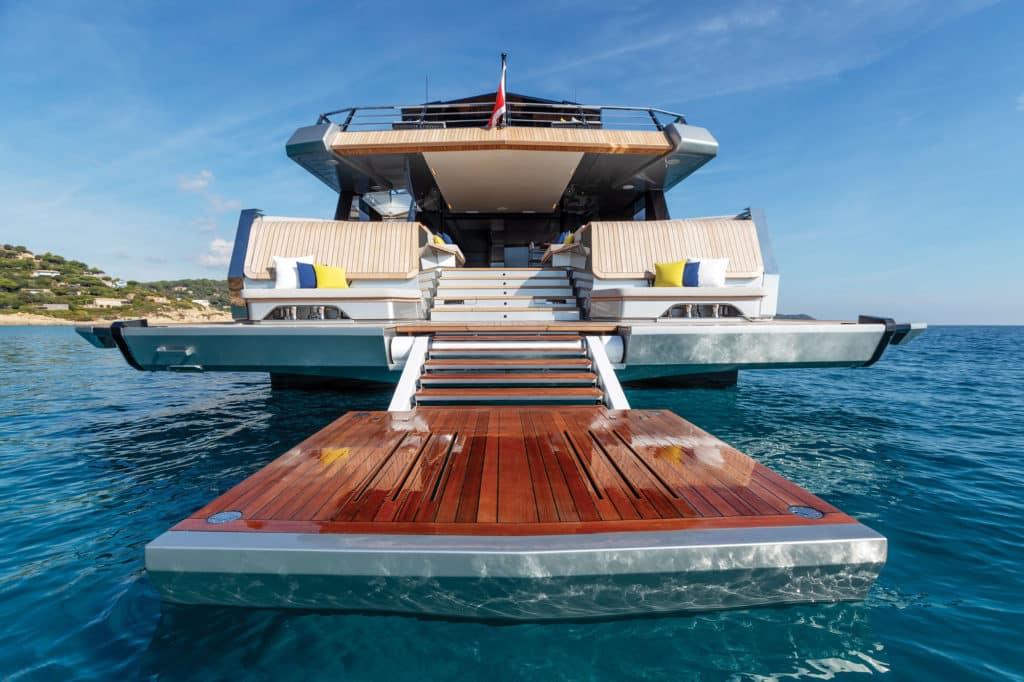
Why WHY200? The acronym stands for Wally Hybrid Yachts, which has nothing to do with hybrid propulsion, but rather a hull designed for a range of displacement and semidisplacement cruising speeds. And the numerals don’t reference length. They reflect the approximate volume (199 gross tons), which is a lot for a yacht with a length overall of just 89 feet.
But length is not what matters these days. Gross tonnage and beam—the feeling of space—are the important metrics. And on this yacht, that most important effect is achieved.
In all, there’s more than 2,150 square feet of indoor living space, including 1,075 square feet on the main-deck level. Wally says the yacht delivers 50 percent more volume, 60 percent more main-deck area and 40 percent more upper-deck area than any conventional planing yacht of the same length. All of that’s achieved without the speed concessions normally associated with displacement yachts.
Exterior design and styling make the Wally heritage clear, albeit on steroids. The top of the superstructure is virtually all tinted glass. There is extensive hull glazing set into the yacht’s metallic-silver topsides. The top tier effectively wraps around that tall reverse-raked stem, and it’s not just an exterior styling exercise (keep reading).

The transom area is a cross between a beach club and a sailing-yacht cockpit, which is not surprising given the 40 or so supersailers Wally has launched in the past 25-plus years. The swim platform and fold-down quarter-cheeks double as doors for two longitudinal garages. They can also create a walk-around stern.
The aft deck is configured more like a sailing yacht, with a wide central walkway flanked by sun pads and bench sofas, making for a more sociable vibe than a traditional transom sofa that spans the beam. There’s room for a cockpit table, and much of the aft deck is semi-enclosed by windowed buttresses to the sides and a substantial upper-deck overhang, all of which make for a much more intimate space.
Electrically opening glass doors lead to a full-beam main salon. This model has a maximum beam of 25 feet, and at its widest, the salon measures virtually 23 feet from picture window to picture window. A glass-walled structural staircase dominates the space and helps to create zones, all with decorative carbon fiber. The soles throughout the shared spaces are mostly 5-inch-wide teak planks, and the wall paneling is an off-white Alcantara—minimalist, chic and classic Wally. The first hull has a galley to port that Wally refers to as a “show kitchen,” and there’s a day head in the after corner to starboard.
The door to this model’s star attraction, the 398-square-foot master stateroom, is forward in the salon. What makes this space uber-special is bow glazing that allows a proper view. The WHY200 is the first production yacht with this feature. It’s 950 square inches, which is nearly the size of a 50-inch TV screen. I walked from there into the stateroom, which has a 200-degree wraparound panorama across an island berth with 6-foot-11-inch headroom. The feeling is impressive.

Other layout options allow for one big head and no island berth, or an entertainment space with a bar and circular dining table. The space is all the more dramatic for being ultra-quiet, principally because the engines are so far aft.
Belowdecks aboard Hull No. 1 are three en suite guest staterooms off a central fore-aft passage, all with inboard-facing athwartships berths. The biggest stateroom is in the bow, with a king-size berth to port and his-and-hers heads forward with a shared shower stall between them, plus a sofa. The other two staterooms are amidships and have queens.
There’s also a four-stateroom version available. It trades the forward VIP stateroom for two en suite, twin-berth staterooms with top-and-tail berths.
The amidships crew space spans 344 square feet. There are three cabins for six crewmembers, although the usual complement is likely to be four or five. There also are two shower rooms, a galley and a mess area. Access is via a staircase with two discreet doors to port, one from the forward corner of the aft deck and the other from the after corner of the salon.
The upper deck has a sky lounge with wraparound sofas. It’s a light and bright space, not least for having glazing on five sides of the cube. Not only are there glass doors to the terrace, picture windows to the sides and a glass wall separating the bridge, but there also are skylights above. All that glass means superb views from the helm for normal navigation.
The bridge console is addressed by three seats that are carbon-backed—one for the pilot and the others for guests. Doors on each side connect with partial side decks and the raised foredeck.

The amount of space aboard owes everything to the quad Volvo Penta IPS diesel installation beneath the aft deck. There are two options: four D13-900 IPS1200s or D13-1000 IPS1350s. At one-third load, they deliver maximum speeds of 20 knots or 23 knots, respectively, and brisk cruises of 16 or 19 knots. Above that load state, expect speeds to decrease by around a half-knot for every extra ton.
Similarly, ranges vary from 410 nautical miles at 17 knots for the smaller engines to 350 nm at 20 knots for the bigger package. At 10 knots, both setups should stretch to give or take 1,100 nm on four engines. And there’s always the option to run on just two engines, as IPS installations are always more efficient at higher revs.
Tank capacity is 3,170 gallons. Stabilization on the first hull includes fins and gyros. Given that most owners are likely to spend more time at anchor than underway, the extra investment in onboard comfort is never going to be wasted. The two Seakeeper 16s and Humphree electric fins were all active during our runs, and the yacht was rock-steady throughout, hardly heeling even through hard-over turns. Moreover, that high bow rises little more than 2.5 degrees throughout the speed range, which makes moving around while underway so much easier.
Wally has always pushed the boundaries of boatbuilding. With the WHY200, the builder has introduced a forward-thinking exterior design with superyacht space, surprising sea views and admirable performance. Once I was aboard, it didn’t take long for this yacht’s “why” to become a “wow.”
Anchor Access
The ground tackle is all in a compartment beneath the owner’s stateroom, accessible via a crawl space from the VIP closet.
A Yacht is Born
Chief designer and Wally founder Luca Bassani gave creative inputs for this model, working with the Ferretti Group’s central design and engineering team. Laurent Giles in England handled the naval architecture, and the yacht was tank-tested at Solent University’s facilities in Southampton. The minimalist interior scheme comes from Andrea Vallicelli’s studio in Rome. The WHY200 is built at the Ferretti Group’s Mondolfo, Italy, plant.
Semidisplacement hulls make a lot of sense. “You get a much more comfortable ride when you are able to punch through waves at 16, 18, 20 knots,” Bassani says, “but then you have to design accordingly to cope with those waves. …One way of doing that is [to] raise the bow sufficiently, and we’ve used that logic to create a whole new space aboard.”
Toy Stowage
The yacht has two stern garages, each capable of accommodating a 13.5-foot tender or a PWC/Seabob/paddleboard combo.
Take the next step: wally.com









